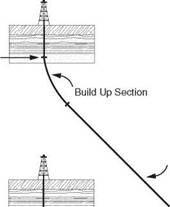 PLANNING The Profile Of The WELL
PLANNING The Profile Of The WELL
There are basically three types of deviated well profile (Figure 3):
• Build and Hold
• S-shaped
• Deep kick-off
The build and hold profile is the most common deviated well trajectory and is the most simple trajectory to achieve when drilling. The S-shaped well is more complex but is often required to ensure that the well penetrates the target formation vertically. This type of trajectory is often required by reservoir engineers and production technologists in exploration and appraisal wells since it is easier to assess the potential productivity of exploration wells, or the efficiency of stimulation treatments when the productive interval is entered vertically, at right angles to the bedding planes of the formation. The deep kick-off profile may be required when drilling horizontal wells or if it is necessary to drill beneath an obstacle such as the flank of a Salt Diapir. This well profile is the most difficult trajectory to drill since it is necessary to initiate the deviated trajectory in deeper, well compacted formations.
4.1 Parameters Defining the Wellpath
There are three specific parameters which must be considered when planning one of the trajectories shown in Figure 3. These parameters combine to define the trajectory of the well and are the:
• Kick-off Point
• Buildup and Drop off Rate and
• Tangent Angle of the well
(a) The Kickoff Point (KOP)
The kick off point is the along hole measured depth at which a change in inclination of the well is initiated and the well is orientation in a particular direction (in terms of North, South, East and West). In general the most distant targets have the shallowest KOPs in order to reduce the inclination of the tangent section of the well (see below). It is generally easier to kick off a well the shallow formations than in deep formations. The kick-off should also be initiated in formations which are stable and not likely to cause drilling problems, such as unconsolidated clays.
(b) Buildup Rate (BUR) and Drop Off Rate (DOR)
The build up rate and drop off rate (in degrees of inclination) are the rates at which the well deviates from the vertical (usually measured in degrees per 100 ft drilled). The build-up rate is chosen on the basis of drilling experience in the location and the tools available, but rates between 1 degree and 3 degree per 100ft
|
|
of hole drilled are most common in conventional wells. Since the build up and drop off rates are constant, these sections of the well, by definition, form the arc of a circle. Build up rates in excess of 3 degrees per 100 ft are termed doglegs when drilling conventional deviated wells with conventional drilling equipment. The build up rate is often termed the dogleg severity.
(c) Tangent (or Drift) Angle
The tangent angle (or drift angle) is the inclination (in degrees from the vertical) of the long straight section of the well after the build up section of the well. This section of the well is termed the tangent section because it forms a tangent to the arc formed by the build up section of the well. The tangent angle will generally be between 10 and 60 degrees since it is difficult to control the trajectory of the well at angles below 10 degrees and it is difficult to run wireline tools into wells at angles of greater than 60 degrees.
|
|
|
KOP |
|
Tangential Section |
|
|
|
Drop off Section |
|
|
KOP
KOP
|
|
|
|



